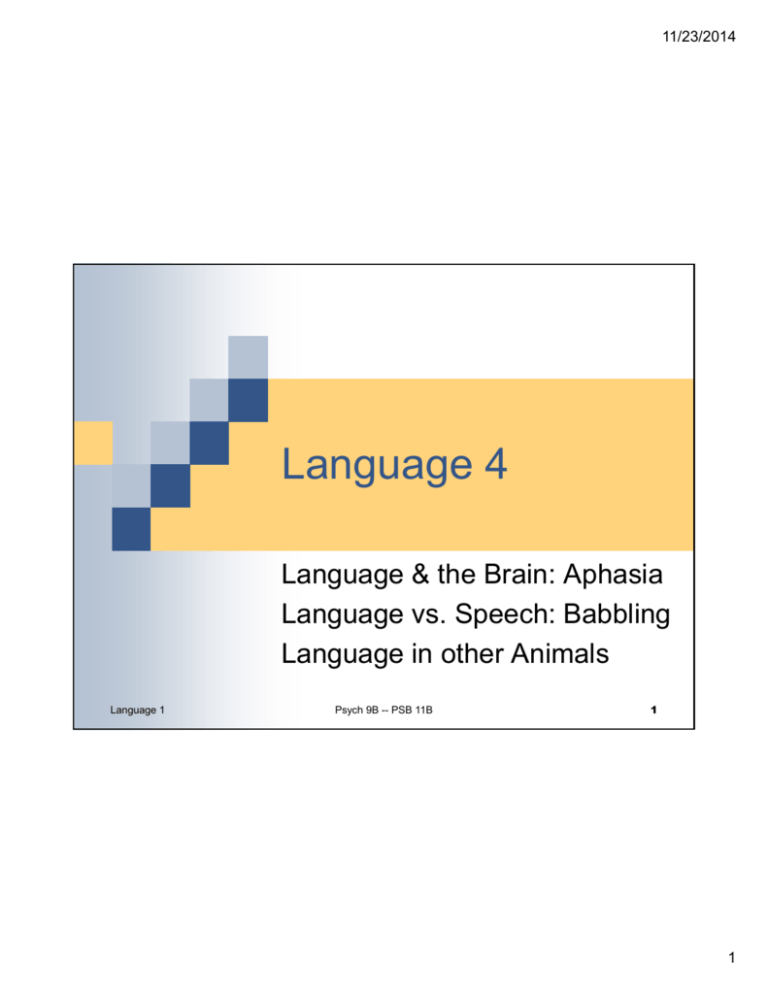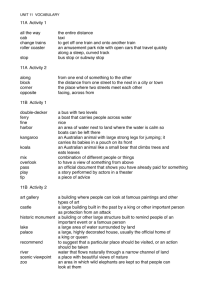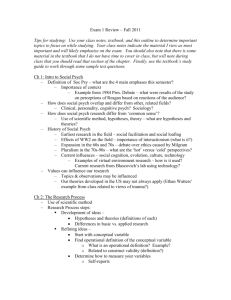Document
advertisement

11/23/2014 Language 4 Language & the Brain: Aphasia Language vs. Speech: Babbling Language in other Animals Language 1 Psych 9B -- PSB 11B 1 1 11/23/2014 A. B. C. D. Aphasia is an acquired condition in which there is impairment of _________ . Speech production Speech perception Language comprehension Any combination of (a) – (c) Language 1 Psych 9B -- PSB 11B 2 2 11/23/2014 Broca’s aphasia Damage to the Left Interior Frontal Gyrus (LIFG) Characterized by Relatively good comprehension Slow and effortful speech Example of a speech produced by a patient with Telegraphic speech: Broca’s aphasia: tendency to omit http://www.youtube.com/watch?v=1aplTvEQ6ew “function words” (e.g., a / of / is) Language 1 Psych 9B -- PSB 11B 3 3 11/23/2014 Localization of Function in the Motor Strip Broca’s Area Language 1 Psych 9B -- PSB 11B 4 4 11/23/2014 Wernicke’s aphasia Damage to the posterior, Superior Temporal Gyrus (pSTG) Example of a speech produced by a patient with Wernicke’s aphasia: Characterized by Fluent but frequently meaningless speech Word substitution errors Impaired comprehension http://www.youtube.com/watch?v=B-LD5jzXpLE&NR=1 Language 1 Psych 9B -- PSB 11B 5 5 11/23/2014 Wernicke-Geschwind Model Speech Input Intention Wernicke’s Area Auditory Cortex Broca’s Area Wernicke’s Area (Contains sound images of words) (Stores motor programs for speaking words) Comprehension Motor Cortex Speech Output Language 1 Psych 9B -- PSB 11B • New data has shown that this model, although important, is inadequate 6 6 11/23/2014 Functional Localization and Lateralization of Speech The Wernicke-Geschwind model influenced thinking in two important ways It encouraged thinking of the left hemisphere as the “language” hemisphere, with primary responsibility for both comprehension and production of language It encouraged thinking of language as highly localized Language 1 Psych 9B -- PSB 11B 7 7 11/23/2014 Brain Imaging Results Implications for Localization Phonology Semantics Structure Poor localization Distributed processing networks Vigneau et al. (2006) Language 1 Psych 9B -- PSB 11B 8 8 11/23/2014 Role of the Right Hemisphere There is good evidence that both sides of the brain, not just the left, contribute to speech and language input processing – speech perception and comprehension. Language output, the planning and control of speech, is weighted toward the left hemisphere in more than 90 per cent of the population. The right hemisphere seems to be used preferentially to interpret sophisticated communications like jokes, metaphors, and irony Language 1 Psych 9B -- PSB 11B 9 9 11/23/2014 Summary: Wernicke-Geschwind model Historically important, suggesting that Left hemisphere is the “language” hemisphere Language processing is strongly localized Newer brain imaging data required that both of these suggestions be revised Language 1 Psych 9B -- PSB 11B 10 10 11/23/2014 Hickok-Poeppel (2004) Model of Auditory Language Acoustic-phonetic speech codes Language 1 Psych 9B -- PSB 11B 11 11 11/23/2014 Hickok-Poeppel – 2007 version Language 1 Psych 9B -- PSB 11B 12 12 11/23/2014 Summary: Progress in Science Scientific theories are never complete and correct. Generally they are more accurate than the ones they replace. Wernicke and Geschwind were not wrong on the evidence It remains true that damage to Broca’s area will tend to impair speech output, while damage to Wernicke’s area and neighboring regions tends to degrade speech and comprehension As new and better data became available, this model was both incomplete and contradicted by observations Hickok-Poeppel is “better” because it can explain more of what has been observed They have already replaced their first published original model Their current model will undoubtedly be refined and superseded Language 1 Psych 9B -- PSB 11B 13 13 11/23/2014 A. B. C. The vocal babbling of babies is most likely ______. Of little or no consequence A way to practice and develop their vocal apparatus A reflection of their developing language ability Language 3 Psych 9B -- PSB 11B 14 14 11/23/2014 Babbling as Raw Form of Language Babbling Not simply motor practice “Playing with the raw form of human language” Language without meaning If language is symbols and principles to combine them, The output modality of babbling should not matter Babbling should exist for sign language Measurement problem: How to distinguish babbling from other gestures Language does not need speech to be expressed Language 3 Psych 9B -- PSB 11B 15 15 11/23/2014 A. B. C. D. Which statement best describes your opinion about the use of language by animals? The potential for language is as strong in other animals as it is in humans; however, that capacity is less well developed. Some animals have the mental capacity for language, but this is not develeoped because they lack bodies capable of speech. Some animals are capable of producing and comprehending limited forms of language. Most animals can communicate but lack the capacity for language as we understand it. Language 3 Psych 9B -- PSB 11B 16 16 11/23/2014 Comparing Language in Humans and other Animals Is there some obvious difference between the brains of humans and other animals that might help us understand language processing? A human adult is about 20% larger than a chimpanzee, but has a brain 4 times larger Whales and elephants have brains larger than ours Although smaller, the brains of chimpanzees are similar in shape and structure to ours. Language 3 Psych 9B -- PSB 11B 17 17 11/23/2014 Comparing Language in Humans and other Animals Can other animals learn language? Simple associations of symbols and objects/actions in the world YES Ability to understand and produce – even creatively – simple combinations of symbols YES Ability to understand and process abstract concepts (not necessarily a part of language) YES Ability to understand and produce complex symbol combinations NO Ability to infer structure NO Language 3 Psych 9B -- PSB 11B 18 18 11/23/2014 Summary: Language in Other Animals Animals have communication but not language in its most general sense No one has yet identified the differences between the brains of humans and other animals that have allowed humans uniquely to develop language The lack of a clear-cut structural difference supports the hypothesis that language is not a result of a few, localized brain areas specialized for language. Language 3 Psych 9B -- PSB 11B 19 19 11/23/2014 Looking Forward Wednesday: Chapter Test on Language For Friday Gleitman: Ch. 14, pp. 545 – 562 Norton Reader: Gopnik at al., pp. 146-153 I will go to Phoenix Grill for coffee today Thinking 4 Psych 9B -- PSB 11B 22 20








